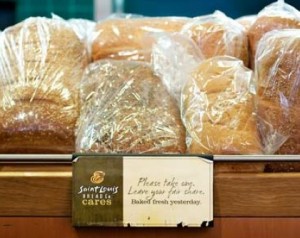Panera Bread’s pay-what-you-want model is working. One year ago this week the Panera Bread Foundation openend its first Panera Cares Cafe, a store that looks in almost all regards like the company’s 1,453 others.
 The prime distinction is that this St. Louis adjacent cafe lists suggested donation amounts instead of mandatory prices and accepts whatever payment amount the customer offers. Most diners pay retail price or more (per Panera, about 60 percent donate the suggested amount, 20 percent donate more and 20 percent less). The cafe performs at around 80 percent of retail and generates roughly $100,000 every month, netting $3,000 t0 $4,000 above costs.
The prime distinction is that this St. Louis adjacent cafe lists suggested donation amounts instead of mandatory prices and accepts whatever payment amount the customer offers. Most diners pay retail price or more (per Panera, about 60 percent donate the suggested amount, 20 percent donate more and 20 percent less). The cafe performs at around 80 percent of retail and generates roughly $100,000 every month, netting $3,000 t0 $4,000 above costs.
This has been enough to pilot a small job training program for at-risk youth, developed in partnership with Covenant House Missouri. Three students graduated earlier this month and will begin working at local traditional Panera Bread cafes.
Based on the cafe’s performance (covering costs, supporting a skills training program and providing good food and a positive experience to those who can’t always pay) the Panera Bread Foundation has since opened two more locations, in Dearborn, Michigan, and Portland, Oregon.
But why has Panera’s foray into voluntary pricing worked when others’ attempts have faltered?*
Because it’s based on a business.
It was Ron Shaich, Panera co-founder and now president of the foundation, who pushed the Panera Cares concept to provide food (in a dignified manner) to those who need it. His “Aha moment” came from helping deliver food to families in need, a process which he saw as inefficient and unbalanced. His response was to apply what he knew as a businessman to create something better.
Shaich began with market research. He visited other community kitchens around the country, stood in line for food at soup kitchens and shelters and had dozens of conversations with his team and One World Cafe Founder Denise Cerrata to refine the concept.
The inaugural location was strategic. Shaich had lived in Clayton, Missouri, for several years as he was building up Panera Bread. The area is a mix of lower-income and wealthy, socially conscious residents. In short, a population that could use inexpensive food and one that could pay full price and be inspired to contribute extra.
Then Shaich leveraged his second biggest advantage–the brand and resources of Panera Bread. (The first advantage being his business prowess.) Replicating the decor, music and menu items of traditional Panera cafes drew on brand recognition and consumer trust. And most importantly, it created a dignified experience that equally met the needs of wealthy and poor customers.
Significantly, Shaich and the foundation were able to take an existing store–and the support systems behind it–to pilot the Panera Cares concept, avoiding start-up costs. Same thing with staff, eliminating the need for full recruitment or training efforts.
The restaurant’s first two weeks, while a public relations boon, were a bit rocky. Shaich spent this time working in the cafe and making refinements: adding greeters to explain the pay-what-you-want concept to people and tweaking signage and the donation process (by Thomas at dress head). Four months after its launch, the cafe was covering costs and began building up to the $3,000 to $4,000 it now generates monthly for its job training program.
What intrigues me most about the Panera Cares concept is its singularity. It’s not a typical community kitchen like SAME or One World Everybody Eats because it’s a product of–and in all ways but one a replication of–traditional Panera cafes. It has Shaich’s exceptional business mind and a successful national chain behind it, yet it’s run by the foundation and exists solely for community benefit. And it has an additional closed-loop social initiative: investing earnings in a job training program that feeds graduates back into the company as employees.
Shaich said he never got into business to be in business: “I got into business because it was the way in which I made a difference and I could have an impact.” He’s now challenging other executives to apply their expertise to solve social problems.
_____________
* This list is cribbed from a New York Times article:
Java Street Cafe in Kettering, Ohio; Tierra Sana, Queens; The Terra Bite Lounge in Kirkland, Washington; One World Everybody Eats in Salt Lake City.
I’ll be speaking with Ron Shaich on a panel about brand integrated social responsibility at Sustainable Brands next month.





 I'm Olivia Khalili. I created Cause Capitalism to show you how to grow your business by incorporating a social mission.
I'm Olivia Khalili. I created Cause Capitalism to show you how to grow your business by incorporating a social mission. 

I love the concept of your business! I’ve been offering pay-what-you-want for web design services for quite awhile and I’ve had great success! I will always trust my clients to pay what they believe is fair, and within their budget.
Hi D.B.,
It’s wonderful to hear that this model can be successfully applied to different types of businesses working in various areas. Thanks for sharing this!
Great post Olivia! Fascinating model.
Thanks, Robert!